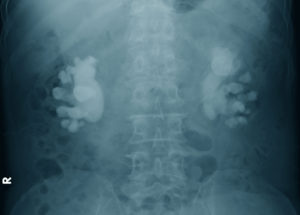
There are four common types of kidney stones. Photo: Shutterstock
If you’ve had an attack of kidney stones, you probably didn’t care what kind of stones they were, as long as they were gone—as soon as possible! But you might be curious to know that not all kidney stones are alike: they don’t look alike, they’re not the same size or shape, and they’re not all composed of the same materials.
When categorizing kidney stones, they fall into four major categories: calcium-based stones, struvite stones, uric acid stones, and cystine stones. Keep in mind that no matter what type of kidney stone you’re diagnosed with, the symptoms are similar but the medical and surgical options can vary. Here’s a quick tutorial about those four types of stones.
Calcium-based stones
Calcium-based stones are far and away the most common type of kidney stones seen in the U.S. and western Europe. Eighty-five percent of all kidney stones have a calcium oxalate component, while a further 8 to 10 percent of all kidney stones are calcium phosphate stones.
Calcium stones can be caused by dehydration, a rare condition called primary hyperoxaluria, and even hospitalization or prolonged bed rest. In very rare cases, calcium stones can form due to overproduction of parathyroid hormones.
Struvite stones
Struvite stones are made mostly of calcium or magnesium, ammonia, and phosphate. Unlike other types of stones, they are relatively soft and can be broken up easily. They are produced by urinary tract infections caused by such organisms as Proteus, Pseudomonas, and Providencia. These stones can grow to be very large and can block the kidney, ureter, or bladder.
People who are at risk of getting struvite stones are those who have been hospitalized for a long time, and those who are often catheterized such as paraplegic or quadriplegic individuals.
Uric acid stones
Over time, increased uric acid levels in the blood may lead to deposits of urate crystals in and around your joints—a condition known as gout. These same urate crystals can end in the urine, then settling in the kidneys and forming stones. About 10 percent of kidney stones are uric acid stones.
As you can imagine, people with gout are at risk of developing uric acid stones. People taking certain chemotherapy medications are also at risk for uric acid stones. The good news is that these stones can be dissolved by keeping the urine alkaline—at a pH higher than 6.5.
Cystine stones
Cystine stones are caused by a rarely occurring genetic condition that causes people to be unable to reabsorb an amino acid called cystine once it’s deposited in the kidneys. The cystine then forms stones. Cystine stones account for about 1 percent of kidney stones, but the rate of occurrence varies based on ancestry, with the condition being very rare in Sweden but much more common in Israeli patients of African origin.
The only thing that causes cystine stones is that rare genetic condition, which is known as cystinuria.
Want to know more about the four major types of kidney stones and how to prevent them? Pick up a copy of my book, Even Urologists Get Kidney Stones, and you’ll get all the tips you need.
